We included HMH Into Math Grade 3 Answer Key PDF Module 4 Lesson 2 Understand the Distributive Property to make students experts in learning maths.
HMH Into Math Grade 3 Module 4 Lesson 2 Answer Key Understand the Distributive Property
I Can understand and know how to use the Distributive Property to decompose factors as a strategy to multiply one-digit numbers.
Spark Your Learning
Taj is drawing a map of the blocks in his town. There are 4 rows with 5 blocks ¡n each row. What is the total number of blocks?

Use the arrays and facts you know to show two ways to find the total number of blocks.
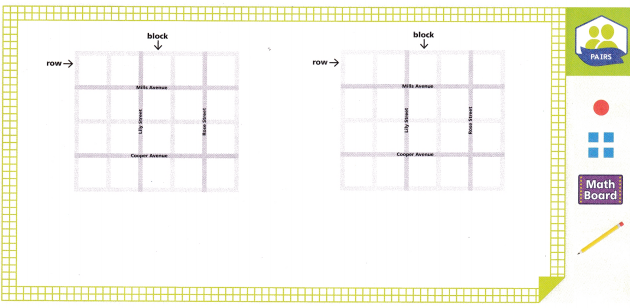
Answer:
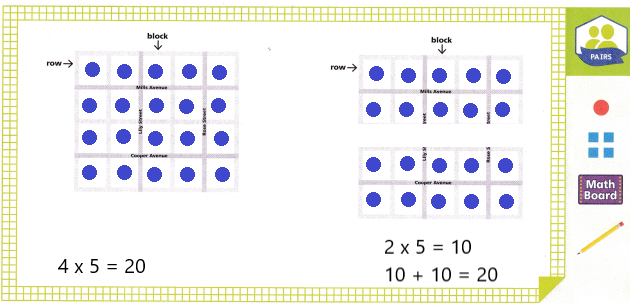
Explanation:
Taj is drawing a map of the blocks in his town
There are 4 rows with 5 blocks in each row
I drew arrays and facts to find the number of blocks
4 x 5 = 20 or
I divided the arrays in 2 parts
2 rows with 5 blocks and 2 more rows with 5 more blocks
2 x 5 = 10
10 + 10 = 20
So, there are 20 blocks in all.
Turn and Talk What facts did you use to solve the problem? Explain.
Answer:
I used 4’s fact with 5 and 2’s fact with 5.
Build Understanding
1. A map of Nell’s neighborhood shows 6 rows with 8 blocks in each row. How many blocks J are there? How can you use an array to help solve the problem?
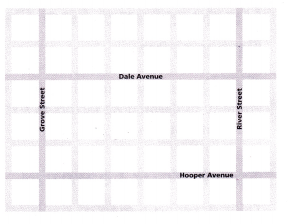
Draw a horizontal line to break apart the array into two smaller arrays for facts you know.
A. How many blocks are in each smaller array?
_______________________
B. Why do you need to add the products of the two smaller arrays?
_______________________
_______________________
C. Nell broke apart her array vertically to show 6 rows of 5 blocks and 6 rows of 3 blocks. What equations can you write for Nell’s arrays?
Answer:

Explanation:
A map of Nell’s neighborhood shows 6 rows with 8 blocks in each row
I drew a horizontal line to break apart the array into two smaller arrays for facts i know
The facts are 3 x 8 = 24
There are 24 blocks in the smaller arrays
Double the product
24 + 24 = 48
So, there are 48 blocks in Nell’s Neighborhood.
If Nell brake apart her array vertically to show 6 rows of 5 blocks and 6 rows of 3 blocks
The equations will be 6 x 5 = 30 and 6 x 3 = 18
30 + 18 = 48
So, there are 48 blocks in Nell’s Neighborhood.
Connect to Vocabulary
The Distributive Property states that multiplying a sum by a number is the same as multiplying each addend by the number and then adding the products.
Example: 5 × 7 = 5 × (3 + 4)
5 × 7 = (5 × 3) ÷ (5 × 4)
5 × 7 = 15 + 20
5 × 7 = 35
D. How many blocks are in Nell’s neighborhood? ____
Answer:
There are 48 blocks in Nell’s Neighborhood.
Turn and Talk With your classmates, compare how you broke apart your arrays. Compare the sums of the products of your smaller arrays. What can you conclude?
Answer:
First i broke the arrays in 2 equal parts with 3 rows of 8 objects
3 x 8 = 24
24 + 24 = 48
And next i broke into 6 rows of 5 blocks and 6 rows of 3 blocks
6 x 5 = 30, 6 x 3 = 18
30 + 18 = 48
The sums of the products of my smaller arrays is same
So, in both ways i found that there are 48 blocks in all.
2. A map of Jodi’s village shows there are 4 rows with 9 blocks in each row. How many blocks are there? How can you use an array and the Distributive Property to help solve the problem?
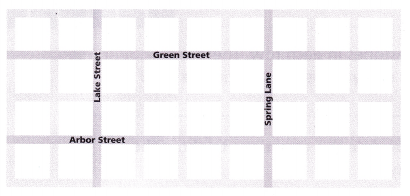
- Draw a vertical line to break apart the array into two smaller arrays for facts you know.
- Use your arrays to complete the equations to show the Distributive Property.
A. Break apart the factor 9. 4 × 9 = 4 × (___ + ___)
B. Multiply each addend by4. 4 × 9 = (4 × __) + (4 × ____)
C. Add the products of the smaller arrays. 4 × 9 = ____ + ____
D. How many blocks are in Jodi’s village? 4 × 9 _______
Answer:
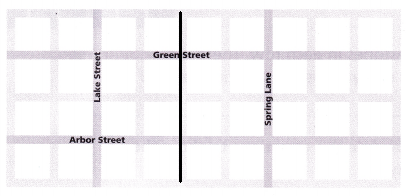
Explanation:
A map of Jodi’s village shows there are 4 rows with 9 blocks in each row
I drew a vertical line to break apart the array into two smaller arrays for facts i know
Break apart the factor 9
4 x 9 = 4 x ( 4 + 5 )
Multiply each addend by4
4 x 9 = ( 4 x 4 ) + ( 4 x 5 )
Add the products of the smaller arrays
4 x 9 = 16 + 20
4 x 9 = 36
So, there are 36 blocks in Jodi’s village.
Check Understanding Math Board
Question 1.
A map of Tran’s town shows 5 rows with 4 blocks in each row. How many blocks are in Tran’s town?
Answer:
20
Explanation:
A map of Tran’s town shows 5 rows with 4 blocks in each row
5 x 4 =
Break apart the factor 4
5 x ( 2 + 2 )
Multiply each addend by 5
( 5 x 2 ) + ( 5 x 2 )
Add the products
10 + 10 = 20
So, there are 20 blocks in Tran’s town.
On Your Own
Question 2.
Use Structure A kitchen counter has 4 rows of tiles with 7 tiles in each row. How many tiles are on the counter?

Answer:
28 tiles
Explanation:
A kitchen counter has 4 rows of tiles with 7 tiles in each row
4 x 7
Break apart the factor 7
4 x ( 5 + 2 )
Multiply each addend by 4
( 4 x 5 ) + ( 4 x 2 )
Add the products
20 + 8
= 28
So, there are 28 tiles on the counter.
Question 3.
A box has 8 gemstones in each row. There are 5 rows. How many gemstones are in the box?
Answer:
40 gemstones
Explanation:
A box has 8 gemstones in each row
There are 5 rows
5 x 8 =
Break apart the factor 8
5 x ( 5 + 3 )
Multiply each addend by 5
( 5 x 5 ) + ( 5 x 3 )
Add the products
25 + 15
= 40
So, there are 40 gemstones in the box.
Use the array to complete the equations to show the Distributive Property.
Question 4.
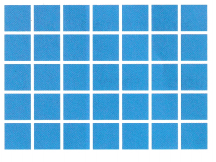
5 × 7 = ![]()
5 × 7 = 5 × (___ + ___)
5 × 7 = (5 × ___) + (5 × __)
5 × 7 = ___ + ___
5 × 7 = ___
Answer:
5 x 7 = 35
Explanation:
5 × 7 = ![]()
5 × 7 = 5 × (5 + 2)
5 × 7 = (5 ×5) + (5 × 2)
5 × 7 = 25 + 10
5 × 7 = 35.
Question 5.

3 × 9 = ![]()
3 × 9 = 3 × (___ + ___)
3 × 9 = (3 × ___) + (3 × __)
3 × 9 = ___ + ___
3 × 9 = ___
Answer:
3 x 9 = 27
Explanation:
3 × 9 = ![]()
3 × 9 = 3 × (5 + 4)
3 × 9 = (3 × 5) + (3 × 4)
3 × 9 = 15 + 12
3 × 9 = 27.
I’m in a Learning Mindset!
How did the way I approached the Distributive Property compare to my partner’s approach?
___________________________________